1. Liu Y, Cheng S, Liu X, Cao X, Xue L, Liu G. Plate waste in school lunch programs in Beijing, China. Sustainability (Basel). 2016; 8:1288.
2. Huang Z, Gao R, Bawuerjiang N, Zhang Y, Huang X, Cai M. Food and nutrients intake in the school lunch program among school children in Shanghai, China. Nutrients. 2017; 9:582. PMID:
28590431.
3. Tang HM, Fang H, Xu HL. Diet and nutrition survey among primary and secondary school students in Minhang district of Shanghai city. Chin J Public Health. 2013; 29:1143–1146.
4. Ministry of the Health People’s Republic of China. WS/T 100-1998. Amount of Nutritional Provision for School Lunch [Internet]. Beijing: Ministry of the Health People’s Republic of China;1998. cited 2021 May 10. Available from:
https://www.renrendoc.com/paper/112965121.html.
5. Zhai FY, Cao RX, Fu JJ, Wang ZH, Zhang LW. Current status of nutritional lunch in primary and high schools of Beijing. Can J Public Health. 2007; 1:7–12.
6. Min K, Wang J, Liao W, Astell-Burt T, Feng X, Cai S, Liu Y, Zhang P, Su F, Yang K, et al. Dietary patterns and their associations with overweight/obesity among preschool children in Dongcheng district of Beijing: a cross-sectional study. BMC Public Health. 2021; 21:223. PMID:
33504346.
7. Zhang F, Hu X, Tian Z, Zhang Q, Ma G. Literature research of the nutrition improvement program for rural compulsory education students in China. Public Health Nutr. 2015; 18:936–943. PMID:
24866472.
8. Zhou L, Wang JX, Jiang B. The impact of rural compulsory education nutrition improvement program on students’ health. Chin Rural Surv. 2021; 2:97–100.
9. Liu J. Building educational community for left-behind children in rural China: a case study of a small rural school in Hubei province. Peddie F, Liu J, editors. Economics, Law, and Institutions in Asia Pacific. Singapore: Springer;2021. p. 15–39.
11. Duan JL, Pan YP, Teng LX, Zhao R, Qin Y. Nutrition quality of self-feeding lunch in the primary and secondary schools in Beijing. Chin J Sch Health. 2012; 33:651–653.
12. Cheng SK, Gao LW, Xu ZR, Tang CC, Wang L, Dhruba Bijaya GC. Food waste in catering industry and its impacts on resources and environment in China. Chin Soft Sci. 2012; 7:106–114.
13. Kim HC. A study on the causal model of students’ perceived service quality, affect and satisfaction in college and university foodservices. Korean J Tourism Res. 2006; 20:245–262.
14. Clemes MD, Gan C, Sriwongrat C. Consumers’ choice factors of an upscale ethnic restaurant. J Food Prod Mark. 2013; 19:413–438.
15. Liljander V, Strandvik T. Emotions in service satisfaction. Int J Serv Ind Manage. 1997; 8:148–169.
16. Oh HM, Cho HJ, Jeong C. An effect of servicescape on emotional response and satisfaction: focusing on Incheon International Airport. J Tourism Leis Res. 2018; 30:119–141.
17. Lee KA, Park SY, Lyu ES. Relationship between foodservice satisfaction and customer loyalty of university dormitory foodservice in Gyeongsangbuk-do area. J Korean Soc Food Sci Nutr. 2017; 38:1271–1278.
18. Jani D, Han H. Influence of environmental stimuli on hotel customer emotional loyalty response: testing the moderating effect of the big five personality factors. Int J Hospit Manag. 2015; 44:48–57.
19. Moon HS. A study on the influences of restaurant choice attributes on the customers emotional response and satisfaction - focusing on the differences in types of restaurants. J Hosp Tourism Stud. 2015; 17:203–218.
20. Park MH, Choi YS, Kim YJ. Comparison of dietary attitudes and attitudes to the school lunch service of elementary and middle school students living in the same region. Korean J Community Nutr. 2002; 7:3–13.
21. Cha SS, Shin MH. The effect of delivery food on customer emotional response and repurchase intention. Korean J Food Health Converg. 2021; 7:1–10.
24. People’s Government of Henan Province. Implementation of the pilot work of the nutrition improvement plan for rural compulsory education students in Henan Province [Internet]. Zhengzhou: People’s Government of Henan Province;2012. cited 2021 May 10. Available from:
http://jyt.henan.gov.cn/2012/02-29/1654292.html.
25. Din N, Rani AA, Ridzuan FHF, Zulkifli CN, Tarmizi SAA, Ghazali N, Abdullah D, Kamal SBM. Gauging students’ perception and attitudes towards Halal products and logos. Radzi SM, Mohd Hanafiah MH, Sumarjan N, Mohi Z, Sukyadi D, Suryadi K, Purnawarman P, editors. Heritage, Culture and Society: Research Agenda and Best Practices in the Hospitality and Tourism Industry. London: CRC Press;2016. p. 729–733.
26. Abdullah D, Hamir N, Nor NM, Krishnaswamy J, Rostum AMM. Food quality, service quality, price fairness and restaurant re-patronage intention: the mediating role of customer satisfaction. Int J Acad Res Bus Soc Sci. 2018; 8:211–226.
27. Krishna M, Lim EC, Ooi CY, Ooi SY, Ooi YW, Tan MW. Customer loyalty to newly opened cafés and restaurants in Malaysia. J Foodserv Bus Res. 2017; 20:525–541.
28. Park SH. The effects of school feeding service quality on students’ practice and satisfaction of school feeding - focusing on high school students in Daegu. Korean J Tourism Res. 2015; 29:69–82.
29. Lee JU, Lee YK, Ahn SM. Effects of experiential value and emotional responses on brand satisfaction and brand loyalty in the family restaurant context. Food Serv Ind J. 2017; 13:123–140.
30. Kim WG, Lee YK, Yoo YJ. Predictors of relationship quality and relationship outcomes in luxury restaurants. J Hosp Tour Res (Wash DC). 2006; 30:143–169.
31. Kamal S, Bukhari N, Abdullah D, Din N. Tourists’ satisfaction and loyalty towards food tourism in Georgetown, Penang. Radzi SM, Mohd Hanafiah MH, Sumarjan N, Mohi Z, Sukyadi D, Suryadi K, Purnawarman P, editors. Heritage, Culture and Society: Research Agenda and Best Practices in the Hospitality and Tourism Industry. London: CRC Press;2016. p. 393.
32. Leninkumar V. The relationship between customer satisfaction and customer trust on customer loyalty. Int J Acad Res Bus Soc Sci. 2017; 7:450–465.
33. Lee YC, Ahn SH. The influence of foodservice servicescape on customers’ emotional reaction and behavioral intention. J Foodserv Manag. 2016; 19:61–78.
34. Kim YK. A study on the relationship between physical servicescape and social servicescape, positive emotion of customer and satisfaction in coffee shop. J Foodserv Manag. 2017; 20:25–55.
35. Jung MW, Son ES, Lee JH. Effects of coffee shop servicescape on the emotional reaction and behavioral intention of customers and the moderating effect of background music. J Hosp Tour Res (Wash DC). 2016; 40:69–86.
36. Moon HS. A study on the Influences of restaurant choice attributes on the customers’ emotional response and satisfaction - Focusing on the differences in types of restaurants. J Hosp Tour Res (Wash DC). 2015; 17:203–218.
37. Anderson JC, Gerbing DW. Structural equation modeling in practice: a review and recommended two-step approach. Psychol Bull. 1988; 103:411–423.
38. Kline RB. Software review: Software programs for structural equation modeling: AMOS, EQS, and LISREL. J Psychoed Assess. 1998; 16:343–364.
39. Lee SY. A study on effect of customer emotion and satisfaction by hotel employee’s nonverbal communication. J Hotel Resort. 2011; 10:139–150.
40. Lee JR, Yoo D, Lee YK. The effect of web interactivity of e-brand on relationship quality and customer loyalty. J Korean Oper Res Manag Sci Soc. 2004; 29:73–93.
41. Baron RM, Kenny DA. The moderator-mediator variable distinction in social psychological research: conceptual, strategic, and statistical considerations. J Pers Soc Psychol. 1986; 51:1173–1182. PMID:
3806354.
42. Preacher KJ, Hayes AF. SPSS and SAS procedures for estimating indirect effects in simple mediation models. Behav Res Methods Instrum Comput. 2004; 36:717–731. PMID:
15641418.
43. Heo J. Heo Jun’s Easily Follow to Structural Equation Modeling MOS. Seoul: Hanara Publishing;2013. p. 104–111.
44. Yim HR, Kim HS. A study on the quality and image of school meal service and student satisfaction with the service: focused on moderating effect of distribution types. Korean J Culinary Res. 2013; 11:11–22.
45. Park JE, Choi KS. Improving perception and satisfaction on middle and high school foodservice: the role of student participation program in serving school meals. Korean J Community Nutr. 2018; 23:243–256.
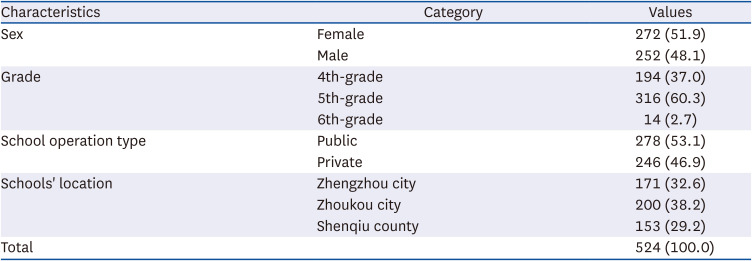
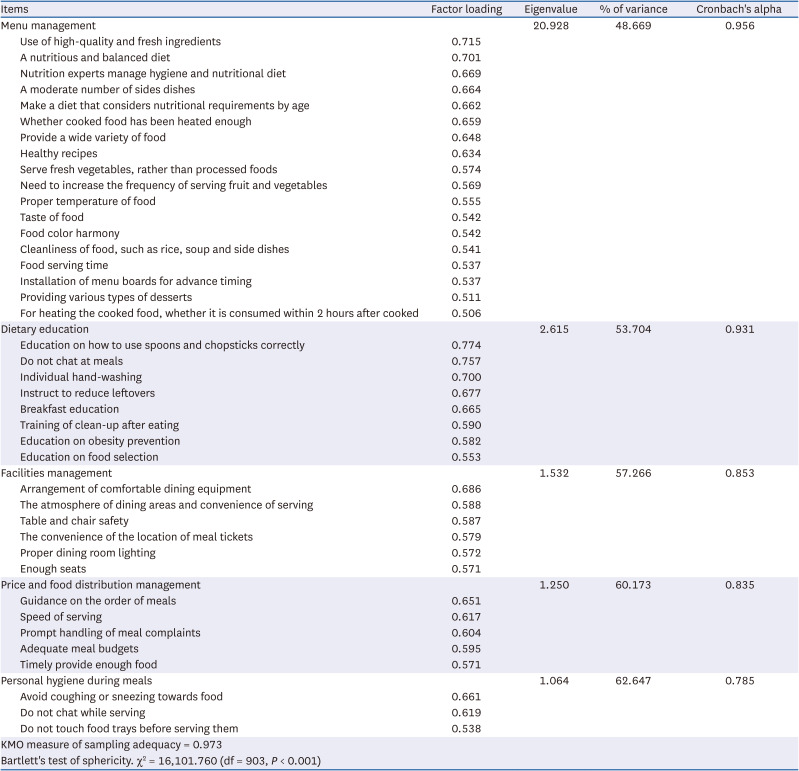


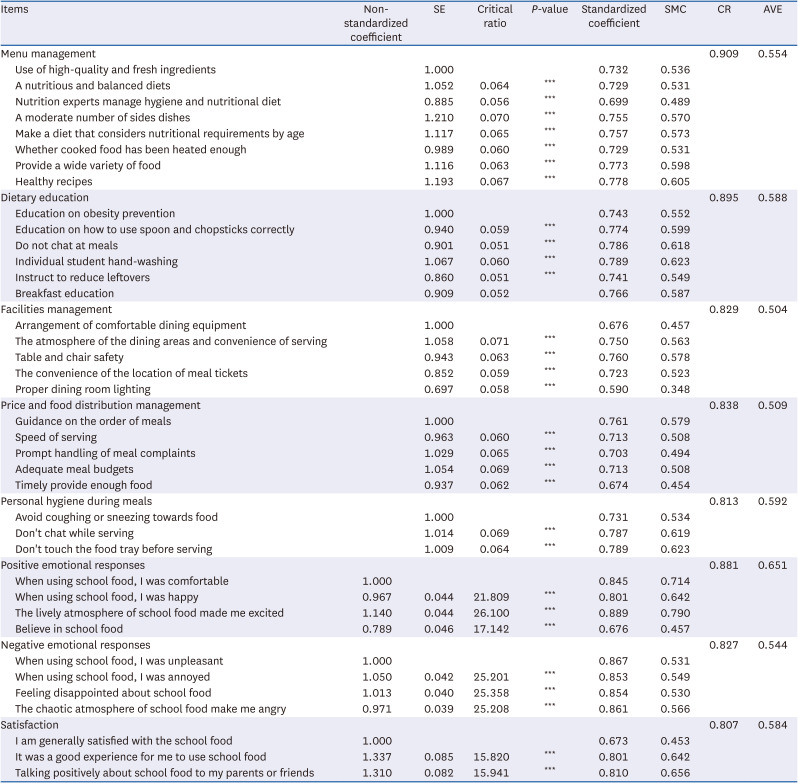
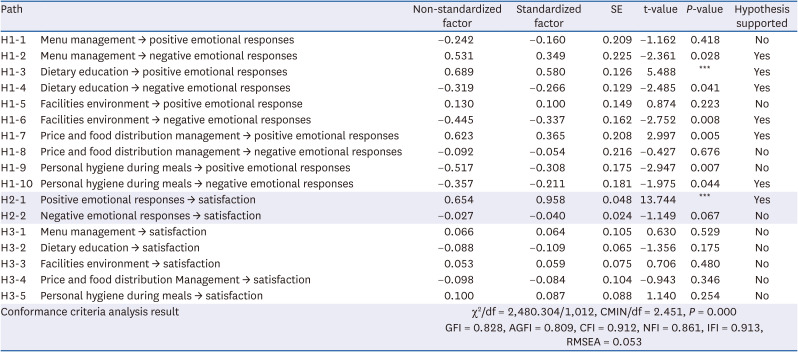





 PDF
PDF Citation
Citation Print
Print



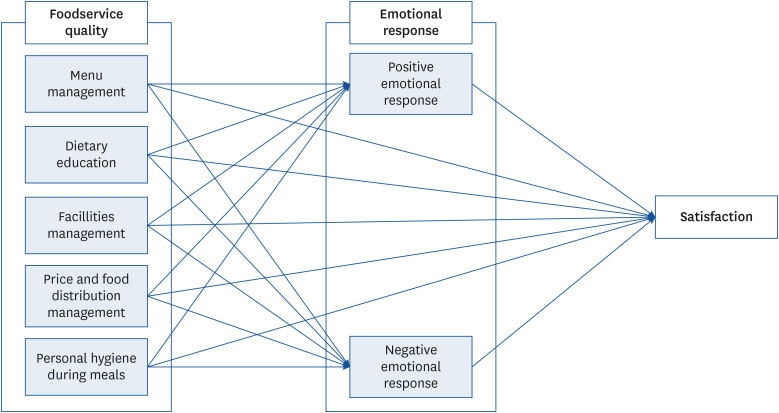
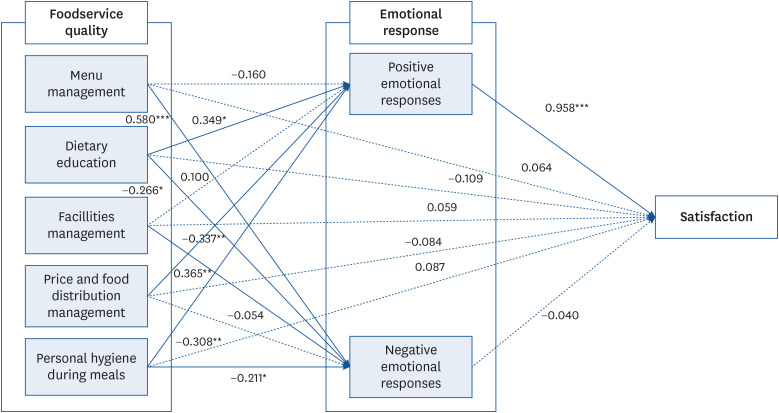
 XML Download
XML Download